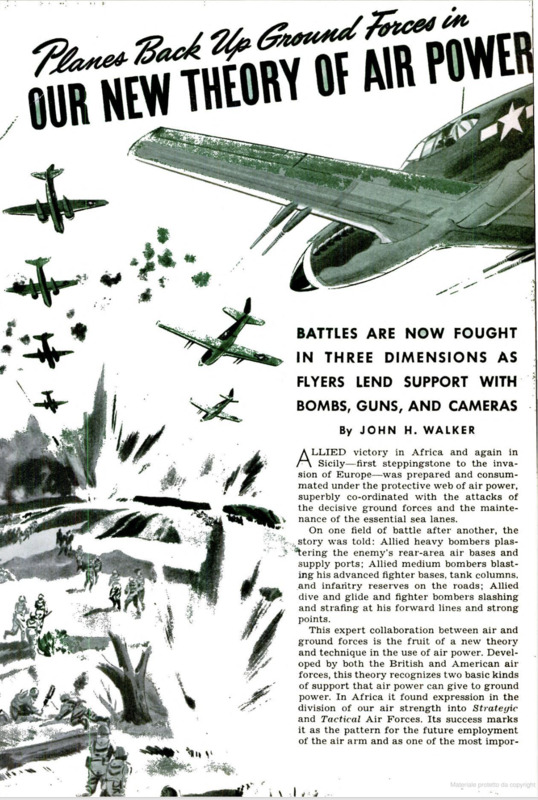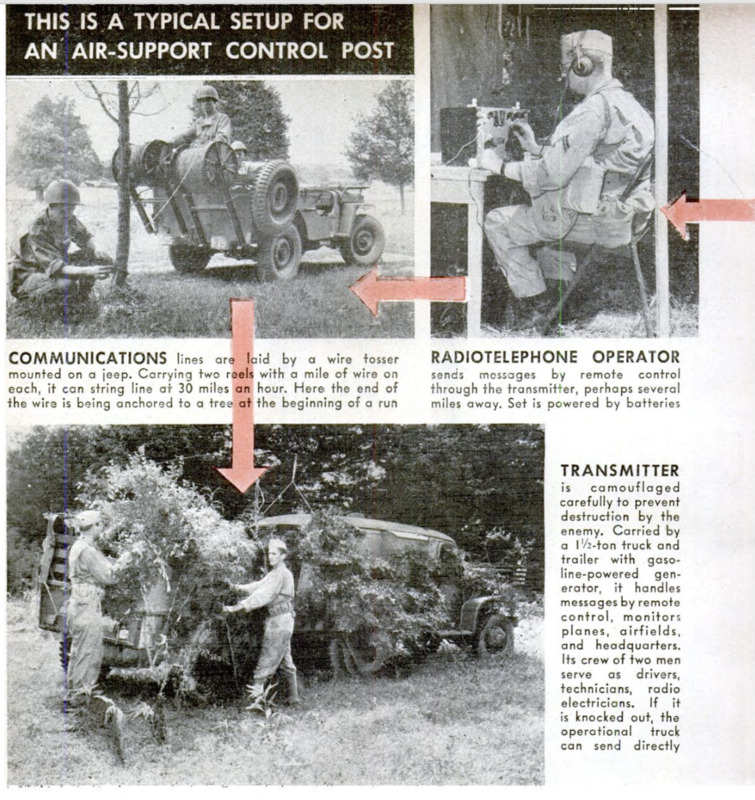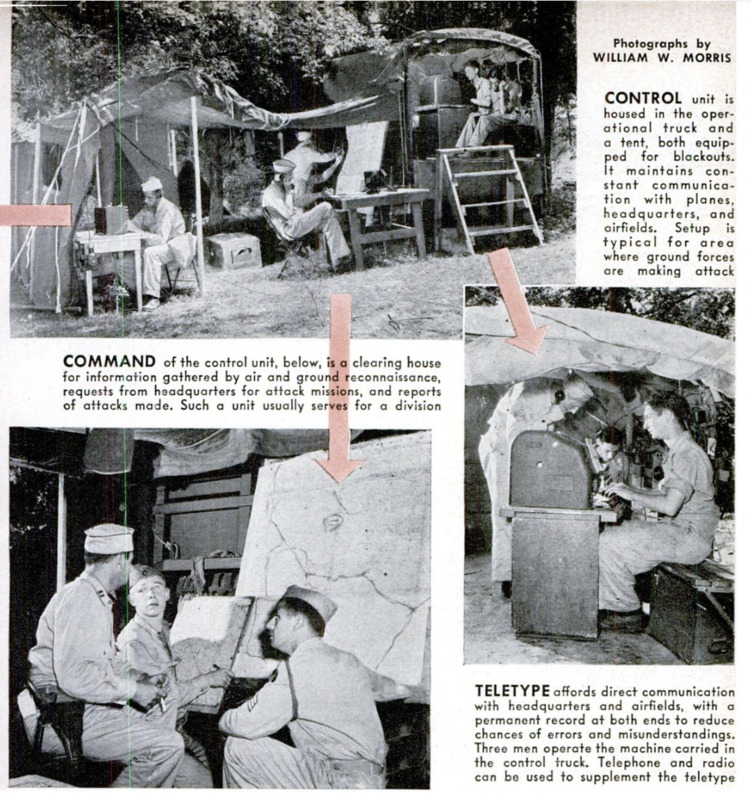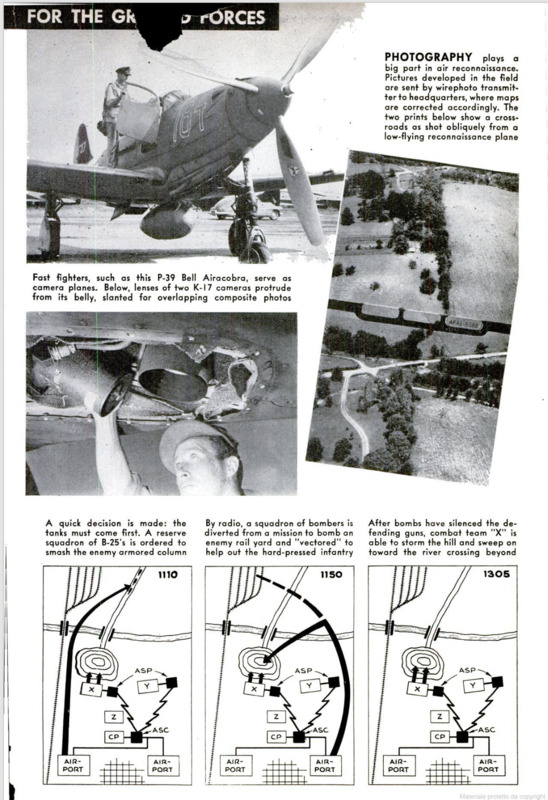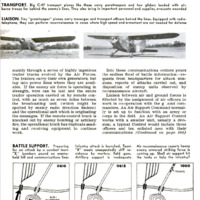-
Titolo
-
Planes Back Up Ground Forces in Our New Theory of Air Power
-
Article Title and/or Image Caption
-
Planes Back Up Ground Forces in Our New Theory of Air Power
-
extracted text
-
ALLIED victory in Africa and again in
Sicily—first steppingstone to the inva-
sion of Europe—was prepared and consum-
mated under the protective web of air power,
superbly co-ordinated with the attacks of
the decisive ground forces and the mainte-
nance of the essential sea lanes.
On one field of battle after another, the
Story was told: Allied heavy bombers plas-
%ering the enemy's rear-area air bases and
supply ports; Allied medium bombers blast-
ing his advanced fighter bases, tank columns,
and infaritry reserves on the roads; Allied
dive and glide and fighter bombers slashing
and strafing at his forward lines and strong
points.
This expert collaboration between air and
ground forces is the fruit of a new theory
and technique in the use of air power. Devel-
oped by both the British and American air
forces, this theory recognizes two basic kinds
of support that air power can give to ground
power. In Africa it found expression in the
division of our air strength into Strategic
and Tactical Air Forces. Its success marks
it as the pattern for the future employment
of the air arm and as one of the most impor-
tant recent developments in the art of war.
Strategic air power, in this technical
sense, is represented mainly by large bomb-
ers, flying relatively long distances to strike
the enemy in his home areas—war indus- |
tries, communications, ammunition depots,
barracks, port facilities, This can be a form |
of air support, as when Maj. Gen. Jimmy
Doolittle’s heavy bombers crippled the Axis |
African air force by bombing out the sup-
port fields in Sicily and Southern Italy. But
it also may function independently, as in |
the strategic bombing of Germany by the |
RAF and the U.S. Eighth Air Force. |
Air support in its purest, most direct
form, is the job of tactical air power. No |
fixed limit is applied on space, although air-
men have a rule of thumb that tactical
operations will not usually penetrate farther |
than 150 miles into the enemy's territory. |
The British called this type of air power
“close support,” although no one has yet
been able to give a satisfactory answer to the |
inevitable question, “How close is close?”
Its main work is the bombing and strafing |
of the enemy at the precise time and place
that will assist infantry or armored troops
to overcome local resistance.
The old notion that air-ground support
was entirely confined to light and dive
bombardment has been completely over-
thrown. Any bomber, up to the giant B-17's |
and B-24's, may be used on a support mis-
sion. As a matter of military economy, how- |
ever, light or medium bombers usually can |
perform an air-support assignment with
greater speed and efficiency. |
Air support can use a fighter plane to
strafe the enemy, a glide or low-level bomb-
er to drop delayed-action bombs on his
columns, a dive bomber to plunk a load of
high explosive on a strong point, a medium
bomber to lay a stick or a salvo of ruin |
across a fortified position, or let down a
string of delayed-action parachute bombs |
in a low-altitude sweep across a troop or
truck concentration. |
Liaison and reconnaissance planes com- |
plete the list of air equipment used, with all |
types represented from tiny “grasshopper”
planes that can land and take off in open
fields, to converted twin-engined Lightning
fighters that can outpace or outclimb any-
thing the enemy could put in the air. |
Men and planes do the fighting, but the |
lifeblood of their work is communications,
and here again every method is put to use,
from the simple act of waggling a plane's
wings or dropping a message, to the most
highly developed radio and wire equipment. |
Basic communications from headquarters |
to air bases are carried out by teletype
wherever possible. Teletype is unique in
providing both ends with an instantaneous,
permanent copy of the order or message, |
thus cutting the chance of error or mis-
understanding down close to zero. The tele-
phone and radio circuits supplement this,
and radio naturally is invaluable for com-
munication with planes in flight, when plans |
must be altered at the last moment.
Wire-tossing jeeps that lay phone and
teletype wires at 30 miles an hour help keep
the communications system functioning even |
during periods of rapid movement. Radio |
communication in the field is carried on
mainly through a series of highly ingenious
trailer trucks evolved by the Air Forces.
The trailers carry their own generators, but
tap into power lines where they are avail-
able. If the enemy air force is operating in
strength, wire can be laid and the entire
trailer operation carried on by remote con-
trol, with as much as seven miles between
the broadcasting unit (which might be
spotted by enemy radio direction finders)
and the operational unit which is originating
the messages. If the remote-control truck is
knocked out by enemy bombing or artillery
fire, the operational truck has duplicate send-
ing and receiving equipment to continue
work.
Into these communications centers pours
the endless flood of battle information—re-
quests from headquarters for attack mis-
sions, reports of attacks carried out, and
disposition of enemy units observed by
reconnaissance aircraft.
Liaison between air and ground forces is
effected by the assignment of air officers to
work in co-operation with the g ound com-
manders. An Air Support Command normal-
ly is set up to function with an army or
corps in the field. An Air Support Control
works with a smaller unit, usually a divi-
sion; a typical Control would include three
officers and ten enlisted men with their
communications
equipment. An Air Support party —some-
times a single liaison officer—is attached to
a field unit, such as a regimental combat
team.
These men funnel the inflowing mass of
information, strain out what is important,
pass on what the ground commander should
know, and expedite requests for air support
at specific places and times. Their work
must be cool, unhurried, yet rapid and
precise. The plans they draw up and the
orders they give tell the story.
The complexity of air support, the fluid
brilliance with which it functions in battle,
is almost impossible to visualize without
seeing it in action—and few civilians ever
can have the chance to see it. Even the war
correspondents who get behind the scenes
of military operations are barred by security
regulations from describing the technical
workings of the machine.
To give a clear, dramatic picture of air
support, POPULAR SCIENCE, with the co-
operation of Army Intelligence sources, has
arranged an account of one day's air-ground
operations on a divisional front. It is ac-
curate in every detail, although the descrip-
tion is sufficiently generalized that mo in-
formation can be revealed to the enemy.
The opposing forces are facing each other
along a line lying roughly between the town
of X and Unknown River. Our forces are
attacking to the north, while the enemy,
giving ground slowly, is attempting to hold
south of the river. At dark our troops have
been stalled by stubborn resistance. The
division commander has decided that he
must lean heavily on air support in the
next day's fighting. |
The battle plan is set up at a conference
in the tent of the chief of staff. Attack is to
be resumed in the morning, with Combat
Team X making the main effort on the left.
Team Y will hold the right flank and Team
Z will be held in reserve. The first need is
for thorough air reconnaissance far behind
the enemy line. The second is for heavy air
support, as most of the artillery will have to
be concentrated on a relatively narrow front
in support of Combat Team X.
Air Commander recommends continued
pressure to keep the enemy air force pinned
down, plus a heavy bombardment of key
rail lines. As for the direct support of the
attack, that is a matter of careful timing.
The infantry push is scheduled for 0615,
preceded by a 10-minute artillery barrage
of maximum violence, beginning at 0600.
Air support is to strike at precisely the
interval, hitting at 0610 with a low-level at-
tack by six A-36 Mustang fighter-bombers.
Two minutes later the pounding will be
taken up by another flight of six A-24 dive
bombers.
As an indication of the precision with
which air and ground operations are inte-
grated, the artillery barrage will end with
the firing of smoke shells to mark the ob-
jective for the diving planes; the last dive
bomber gives the infantry the signal to go
ahead by waggling its wings. Our own
front lines will be marked with colored
smoke to obviate any danger of an error in
bombing objectives.
The chief of staff okays these arrange-
ments and orders the necessary reconnais-
sance and photographic air missions to be
worked out with the G-2 (intelligence) of-
ficer. Next comes a conference in the Air
Support Control office, usually located near
the divisional command post. The G-3 (op-
erations) officer explains the plans for
ground operations, while the Air Command-
er outlines his operations to the liaison of-
ficers of the various air groups — recon-
naissance, dive bombers, medium bombers,
and fighter planes.
The complex process of mounting a co-
ordinated air-ground operation moves along
as the air support and divisional signal offi-
cers go into a huddle of their own, check
over their wire and radio communications,
shift some of the radio frequency bands
which are jamming up against powerful
enemy transmitters, and arrange a code of
visual smoke and panel signals. Finally, the
Air Commander is ready to issue his attack
and operations orders, which are teletyped
to the airdromes over the A-2 wire net.
At dawn the attack begins, with a thun-
dering artillery barrage pouring down on
the hill which is the enemy's chief point of
resistance. With split-second timing, at
0610, the artillery fires its smoke shells, the
infantrymen set off red smoke to mark our
advanced lines, and out of the low-hanging
mists roar the A-36 Mustangs, to strike with
their bombs, then vanish. Immediately the
Douglas Dauntless A-24 dive bombers ar-
rive, peel off one by one, and smash at the
target. As the last plane gives the signal
by rocking its wings, the infantry attack is
launched.
While the ground fighting grows in inten-
sity, the planned air operations go ahead
with attacks on enemy air fields and supply
lines. About 10 am. full reconnaissance
reports and air photographs from 30,000 feet
reveal an alarming development. A heavy
enemy striking force, including 100 tanks
and additional armored and supply vehicles,
is moving up on the rear roads, clearly head-
ing for the point of our main attack.
Meanwhile the infantry advance has run
into terrific opposition at the contested hill,
and has been stopped dead in the woods at
the foot of the slope by heavy fire from mor-
tars, machine guns, and 77-mm. field guns.
The infantry commander has learned that
he cannot get any additional artillery sup-
port, and has sent a hurry call for help to
his accompanying Air Support Party of-
ficer, who radios Air Control to ask what
missions might be assigned or diverted to
help pull the situation out.
Here air command has two new and press-
ing problems. The enemy-held hill needs
our attention; so do the approaching tanks.
But ground-force headquarters must deter-
mine the relative priorities involved, and the
division chief of staff unhesitatingly puts
the tank column first. A reserve squadron
of B-25's (North American Mitchell medium
bombers) is ready, and is ordered into ac-
tion through the flexible system of control.
Photo maps and latest reconnaissance
data are hastily assembled, and the crews
file into their field headquarters for brief-
ing—an informal but deadly serious process.
The youthful squadron leader explains cas-
ually that “our doughfoots are in a jam,
and it’s up to us to deliver a low-level at-
tack that will stop a column of enemy
tanks. They're getting too close to a spot
that's already too hot.”
He shows them the map point where they
will take formation, echeloned to the right.
The attack will be pressed home at extreme
low altitude, with intervals of 2,000 feet.
“Give 'em your forward guns on the way
in, and release all bombs in train.” Fighter
escort is arranged with a near-by field. The
combat crews pile into jeeps and trucks
and roll out to their planes, scattered around
the dispersal area.
The tank column, rolling south at 20
miles an hour, is attacked at “zero-plus al-
titude.” The first B-25 sweeps in over the
trees, its guns blazing, and cuts loose with
its bombs, which have delayed-action fuses
set for the planned attacking interval so
that they will explode just after the plane
is out of the way and before the next at-
tacker slashes by.
The formidable armored column disinte-
grates into a wild, scrambling mass of ve-
hicles and men. Within 10 minutes the road
is strewn with burned and blackened equip-
ment, and the pummeled remnants of the
enemy force are withdrawing in total con-
fusion.
Meanwhile, air support is working on the
problem of the enemy hill. No other re-
serve flight is available, so bombers must
be diverted from a planned operation to
take up this emergency job. By means of
radio equipment and a secret technique, the
air support command “vectors” a squadron
of bombers on their way to blast enemy
railroad yards behind the battle, and steers
them to the new target. They wing in,
drop a blanket of destruction on the enemy
strong points and artillery emplacements,
and clear the way for the combat team to
push ahead, carry its objective, and then
drive on to the river crossing against stead-
ily deteriorating resistance in the late after:
noon.
For air operations the day ends with the
return of the planes and systematic inter-
rogation of the crews to determine the re-
sults of their attacks. This is done at the
air fields, where the airmen gather at the
squadron intelligence officer's office, make
themselves comfortable with coffee and
cigarettes, and then answer the long routine
of questions on what targets they hit, what
effect the bombs had, what air opposition
or ground fire they encountered, what the
weather was like, and so on and on.
But the day ends only in the sense that
this information is summarized and re-
ported on to the higher command, which
starts at once to plan the air support for
the next operation—only a few hours away.
This, in capsule form, is how air support
works. And what it means to the ground
forces was best summed up by the Allied
field commander in Tunisia, General Sir
Harold Alexander, in this message to the
African Tactical Air Command:
“Without your support this drive would
just not have been possible.”
-
Autore secondario
-
John H. Walker (writer)
-
William W. Morris (photographer)
-
Lingua
-
eng
-
Data di rilascio
-
1943-11
-
pagine
-
49-52, 202, 204, 208, 210
-
Diritti
-
Public Domain (Google digitized)
-
Archived by
-
Matteo Ridolfi
-
Alberto Bordignon (Supervisor)
